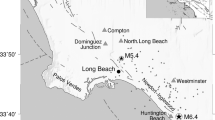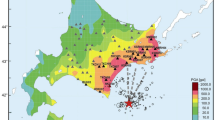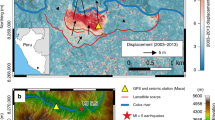Abstract
It has been known since at least 1898 (ref. 1) that sediments can amplify earthquake ground motion relative to bedrock. For the weak ground motion accompanying small earthquakes, the amplification due to sediments is well understood in terms of linear elasticity (Hooke's law)2, but there has been a long-standing debate regarding the amplification associated with the strong ground motion produced by large earthquakes. The view of geotechnical engineers, based largely on laboratory studies, is that Hooke's law breaks down at larger strains causing a reduced (nonlinear) amplification. Seismologists, on the other hand, have tended to remain sceptical of this nonlinear effect, mainly because the relatively few strong-motion observations seemed to be consistent with linear elasticity. Although some recent earthquake studies have demonstrated nonlinear behaviour under certain circumstances3,4, the significance of nonlinearity for the type of stiff-soil sites found in the greater Los Angeles region remains unresolved5. Here we report that ground-motion amplification due to sediments for the main shock of the 1994 Northridge earthquake was up to a factor of two less than the amplification observed for its aftershocks. These observations imply significant nonlinearity in such amplification, and bring into question the use of measurements of weak ground motion to predict the strong ground motion at sedimentary sites.
This is a preview of subscription content, access via your institution
Access options
Subscribe to this journal
Receive 51 print issues and online access
$199.00 per year
only $3.90 per issue
Buy this article
- Purchase on Springer Link
- Instant access to full article PDF
Prices may be subject to local taxes which are calculated during checkout



Similar content being viewed by others
References
Milne, J. Seismology 1st edn (Kegan Paul, Trench, Truber, London, ( 1898)).
Aki, K. Local site effects on strong ground motion. Proc. Earthq. Eng. Soil Dyn. II, 103–155 ( 1988).
Bersenev, I. A. & Wen, K.-L. Nonlinear soil response — A reality? Bull. Seismol. Soc. Am. 86, 1964–1978 (1997).
Aguirre, J. & Irikura, K. Preliminary analysis of non-linear site effects at Port Island array station during the 1995 Hyogoken–Nambu earthquake. J. Nat. Dis. Sci. 16, 49– 58 (1995).
Petersen, M. D. et al . Seismic ground-motion hazard mapping incorporating site effects for Los Angeles, Orange, and Ventura counties. Bull. Seismol. Soc. Am. 87, 249–255 ( 1997).
Andrews, D. J. Objective determination of source parameters and similarity of earthquakes of different size. Earthq. Source Mech. Geophys. Monogr. 37 6, 259–268 (1986).
Field, E. H. & Jacob, K. H. Acomparison and test of various site response estimation techniques, including three that are not reference site dependent. Bull. Seismol. Soc. Am. 85, 1127–1143 (1995).
Wald, D. J. et al. The slip history of the 1994 Northridge, California earthquake determined from strong-motion, teleseismic, GPS, and leveling data. Bull. Seismol. Soc. Am. 86, S49–S70 (1996).
Archuleta, R. J. & Hartzell, S. H. Effects of fault finiteness on near-source ground motion. Bull. Seismol. Soc. Am. 71, 939–957 ( 1981).
Heaton, T. H. Evidence for and implications of self-healing pulses of slip in earthquake rupture. Phys. Earth Planet. Inter. 64, 1–20 (1990).
Hartzell, S. et al. Site resonse for urban Los Angeles using aftershocks of the Northridge earthquake. Bull. Seismol. Soc. Am. 86, S168–S192 (1996).
Peng, J. Y. Spatial and temporal variation of coda Q in California. Thesis, Univ. South California, Los Angeles (1989).
Bonilla, L. F. et al . Site amplification in the San Fernando Valley, CA: Variability of site effect estimation using the S-wave, coda, and H/V methods. Bull. Seismol. Soc. Am. 87, 710–730 (1997).
Cranswick, E. The information content of high-frequency seismograms and the near-surface geologic structure of “hard rock” recording sites. Pure Appl. Geophys. 128, 333–363 (1988).
Steidl, J. et al. What is a reference site? Bull. Seismol. Soc. Am. 86, 1733–1748 ( 1996).
Zeng, Y. & Anderson, J. G. Acomposite source model of the 1994 Northridge earth quake using genetic algorithms. Bull. Seismol. Soc. Am. 86, S71–S83 ( 1996).
Strong-motion data archive of the Southern California Earthquake Center (web address: http://quake.crustal.ucsb.edu/scec/smdb/smdb.html ).
Meremonte, M. et al . Urban seismology — Northridge after shocks recorded by multiscale arrays of portable digital seismographs. Bull Seismol. Soc. Am. 86, 1350–1363 ( 1996).
Data Center of the Southern California Earthquake Center (web address: http://www.scecdc.scec.org.).
Acknowledgements
We thank several members of the Los Alamos National Laboratory (LANL) and the Southern California Earthquake Centre (SCEC) for comments and discussions. The data used in this study were collected by the SCEC, the United States Geological Survey, the California Division of Mines and Geology, the University of Southern California, the Department of Energy, and the City of Los Angeles. This work was supported by LANL Institutional Support (LDRD-IP). E.H.F. received additional support from the SCEC.
Author information
Authors and Affiliations
Corresponding author
Rights and permissions
About this article
Cite this article
Field, E., Johnson, P., Beresnev, I. et al. Nonlinear ground-motion amplification by sediments during the 1994 Northridge earthquake. Nature 390, 599–602 (1997). https://doi.org/10.1038/37586
Received:
Accepted:
Published:
Issue Date:
DOI: https://doi.org/10.1038/37586
This article is cited by
-
New Frequency Domain Framework of Inverse Ground Response Analysis for the Determination of Dynamic Soil Properties of Multilayered System
Indian Geotechnical Journal (2024)
-
Unified approach for evaluation of horizontal site amplification factors with special reference to history of studies on the effects of surface geology on seismic motion
Earth, Planets and Space (2023)
-
Estimating frequency-dependent shear wave velocity in near-surface sediment based on seismic interferometry
Earth, Planets and Space (2023)
-
The role of the west-dipping collision boundary fault in the Taiwan 2022 Chihshang earthquake sequence
Scientific Reports (2023)
-
Site characterization of Algerian broadband seismic stations using earthquake and ambient vibration data: topographic and lithological site-effects investigation
Journal of Seismology (2023)
Comments
By submitting a comment you agree to abide by our Terms and Community Guidelines. If you find something abusive or that does not comply with our terms or guidelines please flag it as inappropriate.



